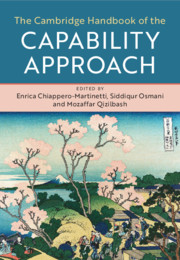Book contents
- The Cambridge Handbook of the Capability Approach
- The Cambridge Handbook of the Capability Approach
- Copyright page
- Dedication
- Contents
- Figures
- Tables
- Contributors
- Foreword
- Acknowledgements
- General Introduction
- Part I Historical Antecedents and Philosophical Debates
- Part II Methods, Measurement and Empirical Evidence
- Part III Issues in Public Policy
- Introduction to Part III
- 25 On Education and Capabilities Expansion
- 26 Capability Approach to Children’s Well-Being and Well-Becoming
- 27 Capability and Disability
- 28 Social Exclusion and Capability Development
- 29 Human Security
- 30 Income Inequality and Human Capabilities
- 31 The Capability Approach and Human Rights
- 32 Capabilities and the Law
- 33 Capabilities, Public Reason and Democratic Deliberation
- 34 Entitlements and Capabilities
- 35 Religion and the Capability Approach
- Index
- References
27 - Capability and Disability
from Part III - Issues in Public Policy
Published online by Cambridge University Press: 11 November 2020
- The Cambridge Handbook of the Capability Approach
- The Cambridge Handbook of the Capability Approach
- Copyright page
- Dedication
- Contents
- Figures
- Tables
- Contributors
- Foreword
- Acknowledgements
- General Introduction
- Part I Historical Antecedents and Philosophical Debates
- Part II Methods, Measurement and Empirical Evidence
- Part III Issues in Public Policy
- Introduction to Part III
- 25 On Education and Capabilities Expansion
- 26 Capability Approach to Children’s Well-Being and Well-Becoming
- 27 Capability and Disability
- 28 Social Exclusion and Capability Development
- 29 Human Security
- 30 Income Inequality and Human Capabilities
- 31 The Capability Approach and Human Rights
- 32 Capabilities and the Law
- 33 Capabilities, Public Reason and Democratic Deliberation
- 34 Entitlements and Capabilities
- 35 Religion and the Capability Approach
- Index
- References
Summary
The capability approach provides three important insights to the debate on disability and justice. First, the approach helps resolve some of the tensions in current views of disability, which either emphasize disability as a natural suboptimal trait, or as prevalently socially determined. The approach suggests instead an interactional understanding of disability, where impairment relates to restrictions in functionings, and disability to the consequent limitations in real opportunities. Second, the approach provides a metric of justice which, unlike other metrics such as the Rawlsian social primary goods, is sensitive to the demands of people with disabilities. The potential lower opportunity for well-being of a person with disabilities can only be evaluated in relation to the absence of a certain functioning, and the related inequality in her real opportunities to lead her life fully. Finally, the capability approach, specifically in Nussbaum’s work, advances the discussion on the equal moral and political status of people with disabilities, and cognitive disabilities in particular, by suggesting that their full citizenship is enacted through forms of surrogacy and guardianship when needed, and by defending their human dignity as participants in the human community.
Keywords
- Type
- Chapter
- Information
- The Cambridge Handbook of the Capability Approach , pp. 544 - 561Publisher: Cambridge University PressPrint publication year: 2020

